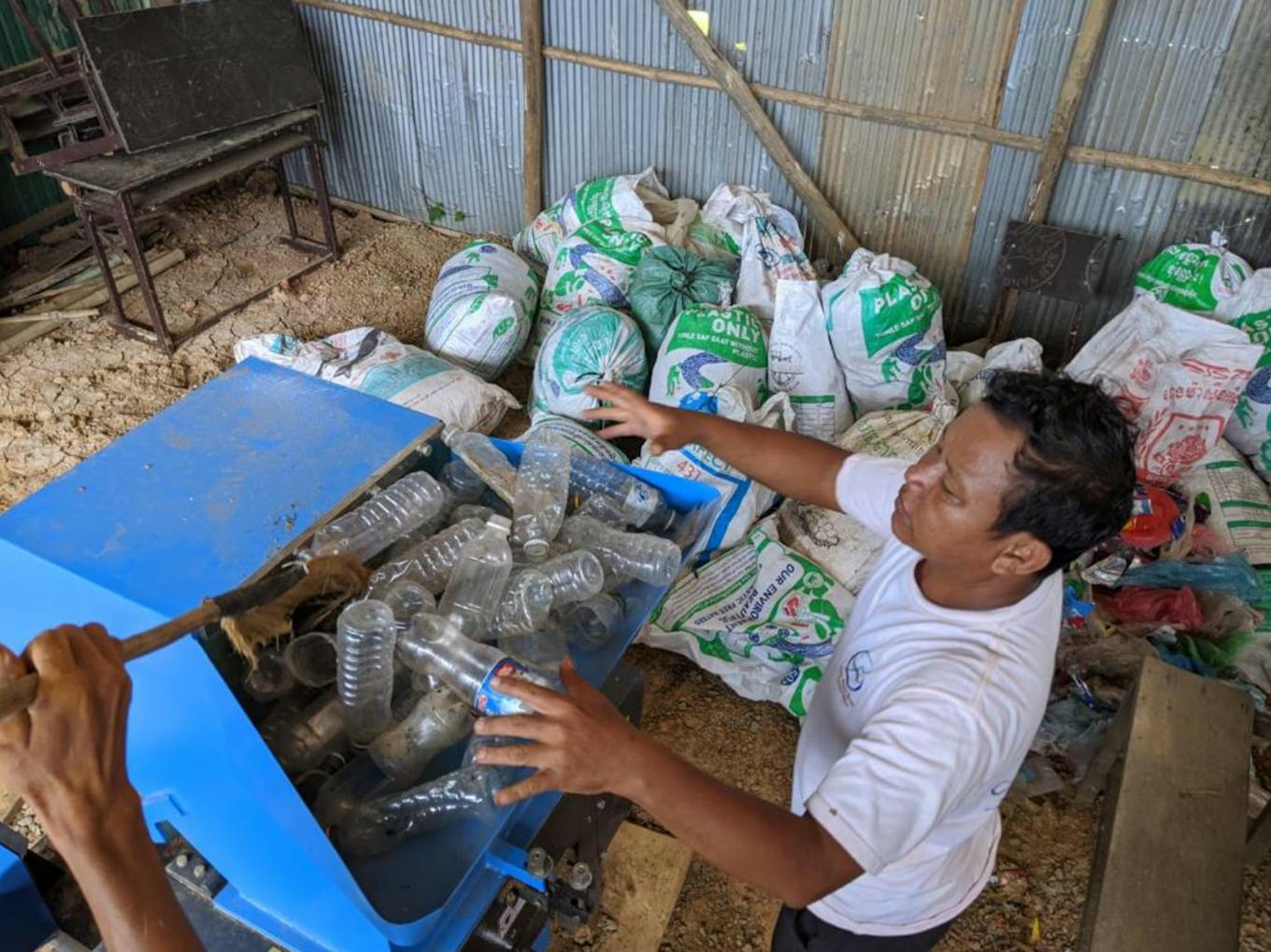The much-hyped United Nations treaty to fight plastic pollution will not work if it focuses too heavily on ways to curb production and trade of the ubiquitous material, says Doug Woodring, founder and managing director of Ocean Recovery Alliance, a Hong Kong and California-based non-profit.
To continue reading, subscribe to Eco‑Business.
There's something for everyone. We offer a range of subscription plans.
- Access our stories and receive our Insights Weekly newsletter with the free EB Member plan.
- Unlock unlimited access to our content and archive with EB Circle.
- Publish your content with EB Premium.
The historic treaty will see a legally binding agreement on plastic pollution come into force next year, and will include a series of provisions to promote the sustainable production and consumption of plastics, from product design to waste management.
It is crucial that, in its clamour to tackle a problem that 175 nations have finally agreed needs fixing, the treaty does not stifle the trade in post-consumer material, says Woodring, a former banker and marathon swimmer whose non-profit has helped build markets for recovered plastics since 2010.
A combination of Covid-19 pandemic restrictions, China’s six year-old ban on waste imports, the Basel Convention on hazardous waste trade and the bad press rich countries have received for exporting their trash to poor nations – dubbed “waste colonialism” – has hurt the international trade in used plastics, Woodring contends.
“Of course we don’t want to send diapers and dirty waste to countries that can’t manage it. But the problem now is countries saying they don’t want any trade [in plastic],” he told Eco-Business. “When you stop the ability to trade, you force every country to create its own circular economy.”
“
The synonym for the plastic trade is ‘waste’. We need to stop calling it waste. This is the feedstock we need for the global circular economy.
Doug Woodring, founder and managing director, Ocean Recovery Alliance
Thailand and Vietnam are among the Southeast Asian nations that have tried to halt the flow of plastic scrap across their borders – which has escalated dramatically since China banned scrap imports in 2017 – as the 10-nation regional bloc has become the de facto dumping ground for the world’s waste.
Malaysia and the Philippines, under pressure to take tougher and more visible action, meanwhile, have both sent plastic waste back to their countries of origin. Former Philippine president Rodrigo Duterte threatened to declare war on Canada in 2019 if it did not accept 2,400 tonnes of used plastics he said had been “illegally dumped” in Manila.
Despite the urgent need for a legal framework to save the ocean from plastic pollution, there is a danger that the UN treaty “backfires” if it focuses too heavily on bans, taxes and other punitive measures to control production – and smothers the global circular economy in the process, Woodring said.
While curbs on production are necessary, he believes that an increase in trade of properly certified and verified post-consumer plastic is beneficial for the sector. The Covid-19 pandemic and the Basel Convention have already killled a lot of the illicit trade in plastic waste, now treaty negotiators just have to be careful not to throw the baby out with the bathwater, he argued.
Eco-Business sits down with Woodring in Hong Kong to hear what he thinks about the tricky business of certifying post-consumer plastic, the countries that could become the world’s recycling hubs, and why brands are not keen on plastic credits – but support Extended Producer Responsibility (EPR) laws.
Plastic certification is controversial. What is your view on how plastic credits are getting certified?
There are two types of plastic credits – one for recovery from the environment and the other for recycling. Some accreditors will only award a credit if the recovered plastic is fully recycled. But in my view there is still huge environmental value in recovering material from rivers and creeks and taking it to landfills. We’ve got to start somewhere – 90 per cent of the world’s plastic doesn’t get recycled as it is, and most developing countries where plastic recovery happens do not have the infrastructure to recycle.
Take our work pulling plastic out of Tonle Sap lake in Cambodia. We recover a lot of plastic from the environment, but it has to be shipped to Vietnam to be recycled, because that’s where the recycling machines are. Also in Hong Kong, for decades, plastic was shipped to mainland China to be recycled – until China stopped waste imports [under the Operation National Sword policy in 2017], so it then had to be landfilled as we don’t have the recycling infrastructure here.
“
Many argue that waste-to-energy is not truly recycling and are concerned that using waste in cement kilns is not good for the planet. Ok, it’s not perfect. But it’s a pretty damn good answer for a lot of garbage that will never be recycled.
If these credit programmes do not give funding for the early-stage recovery, and they only give it to programmes that recycle, that leaves a lot of waste in the environment unrecovered.
We need the brands – the buyers of the credits – to realise that they need to get the plastic out of the environment, because people need to get paid to do the recovery. That’s a key part of the principle of EPR – if you put plastic into the environment, you have to pay to get it out.
The question then is, what happens to the recovered plastic? Does it go to landfill? Waste-to-energy? Many argue that waste-to-energy is not truly recycling and are concerned that using waste in cement kilns is not good for the planet. Ok, it’s not perfect. But it’s a pretty damn good answer for a lot of garbage that will never be recycled.
What about the widely-debated issue around “ocean plastic”?
Some groups want to certify ocean plastic programmes. But in reality, most of the material pulled out of the ocean will never get recycled, because it is not good quality material – it gets biofouled and is unusable. So even chasing this space is a waste of time in my view.
Then there’s “ocean-bound” plastic, which is defined as waste retrieved within 50 kilometres of the ocean. But that’s plastic that needs to be retrieved anyway. Plastic needs to be collected and recovered better everywhere, whether it’s 1,000 miles upstream or on the beach. Brands which only to want to get involved with ocean-bound plastic discredit the collection efforts inland and in cities, which also needs to be better processed and absorbed into the plastic credits system.
The thing is, even the United States has no federal law that mandates plastic recycling. If they did, there would be more investment in collection and recycling infrastructure. So what about other countries? Plastic credits have the ability to feed that space, both in recovery and recycling.
Plastic recovery projects funded by plastic credits would allow recovery programme organisers – like ours – to fund bigger collection programmes within communities and get them the equipment the world needs a million pieces of – small-scale grinders, shredders and compactors to be deployed where they are needed.

A small-scale plastic bottle compressing machine in operation in Cambodia. Image: Ocean Recovery Alliance
So you believe that small-scale decentralised recycling machines are the way to go?
We have a campaign coming up called Get the air out. Plastic packaging that is not compressed or shredded has nine times the volume of material deposited in a recycling bin. A truck filled with 40,000 bottles weighing about a tonne is worth about US$350. If that material is compressed or shredded, you could fit eight to nine times the volume in that truck, which would mean less traffic, less wear and tear on the road and less polluting diesel fumes.
Small businesses which collect and sort the material and compress it with small, decentralised machines, can then sell it to recycler aggregators who can then regularly buy it from them. These machines are no bigger than this table [pointing to a table in a coffee shop]. They cost about US$5,000-US$10,000. But they wouldn’t be funded by the Asian Development Bank or philanthropists, because as soon as there is money to be made from a piece of equipment, they say “we can’t donate to that – this is a business.” This is where plastic credits come in.
Do you think that the big consumer brands with targets to use more recycled content are not going to hit these targets without the right trade rules in place?
Be careful when you say that. Brands will then quickly be able to blame regulators and trade rules. They’ll be let off the hook and say that missing their targets is not their fault – just like they blame the consumer for throwing their product away and creating environmental pollution.
If you look at the three legs of the stool – government, brands and the consumer – brands have more than 80 per cent of the power to fix the problem.
Regulators come into office every few years, they have lobby groups attacking them, they don’t have the research and development funding. And consumers are pretty much like lemmings – we just follow everyone else.
The brands make the packaging, buy the material, know how to mix virgin plastic with recycled plastic, and have the budgets for consumer messaging and can organise and run the takeback programmes. The ball is in their court.
Coca-Cola and Unilever recently said they were not convinced by plastic credits. Why do you think they’re holding this position?
They’re trying to throw uncertainty into the plastic credit system, which will make legislators and other brands feel uncertain and dilute the legitimacy of the system.
By buying plastic credits, they’re now getting charged an amount per tonne [for the plastic they put into the environment] that they never had to pay before.
The bottom line is, if you’re distributing plastic products and packaging all around the world, and you’re not paying to play [the cost of their environmental impact], it’s not fair. If you’re paying US$800 per tonne or even US$300 per tonne [to offset a brand’s plastic use] and you make 1,000 tonnes [of plastic products] per month, that cost becomes huge – and that’s what companies do not want to pay.
The principle with carbon credits is the same – polluter pays. If money is not a factor, businesses won’t care and won’t change. The good thing with plastic credits compared to carbon credits is that with plastic you can see it, touch it and weigh it. It’s a lot harder to see impact with carbon projects.
“
The bottom line is, if you’re distributing plastic products and packaging all around the world, and you’re not paying to play [the cost of their environmental impact], it’s not fair.
But these companies have said they support Extended Producer Responsibility schemes. Why?
Because they know EPR schemes won’t work. There are always too many cooks in the kitchen. EPR systems are usually built around PET bottles, but then other producers come in with different materials and different weights. The chance of getting all those stakeholders to agree on the same pricing system is impossible.
When we were discussing EPR in Hong Kong [Woodring was part of a panel of experts consulted on the implementation of EPR in Hong Kong], brands fought a higher price [for a container deposit scheme] hard. That’s why I left the consortium. We need a decent deposit on the bottle for the system work – five, 10 or 20 cents. The brands were saying the deposit should be 2.5 or 3 cents – but that’s too low. They don’t want to pay the extra amount and always say that the cost will have to be passed on to the consumer. Of course, consumers will pay more, but the companies will absorb some of that cost too.

Plastic collection efforts at Tonle Sap lake, Cambodia. Image: Ocean Recovery Alliance
Which countries could become the world’s major recycling hubs?
The countries that are already big but could get bigger are semi-industrialised nations such as Indonesia, Malaysia, Thailand, Turkey and Mexico. They have the big machinery – and also lower labour costs.
Unfortunately, the West didn’t recycle properly for a long time because the labour was too expensive. If waste is thrown together with chicken grease and coffee grounds, the cost of cleaning and separating out the plastic is too high. Which is why so much waste was exported to developing countries – unsorted and uncleaned.
But if collected properly, and sorted into wet and dry waste, then materials can be recovered and recycled and labour costs won’t be problematic.
Middle-tier countries such as Turkey and Indonesia can do both. They can improve their domestic collection efforts to feed recycling, and also import material for recycling for the players who don’t have the capacity. Their brands can then use it, or they can export it to other manufacturers who need the feedstock.














